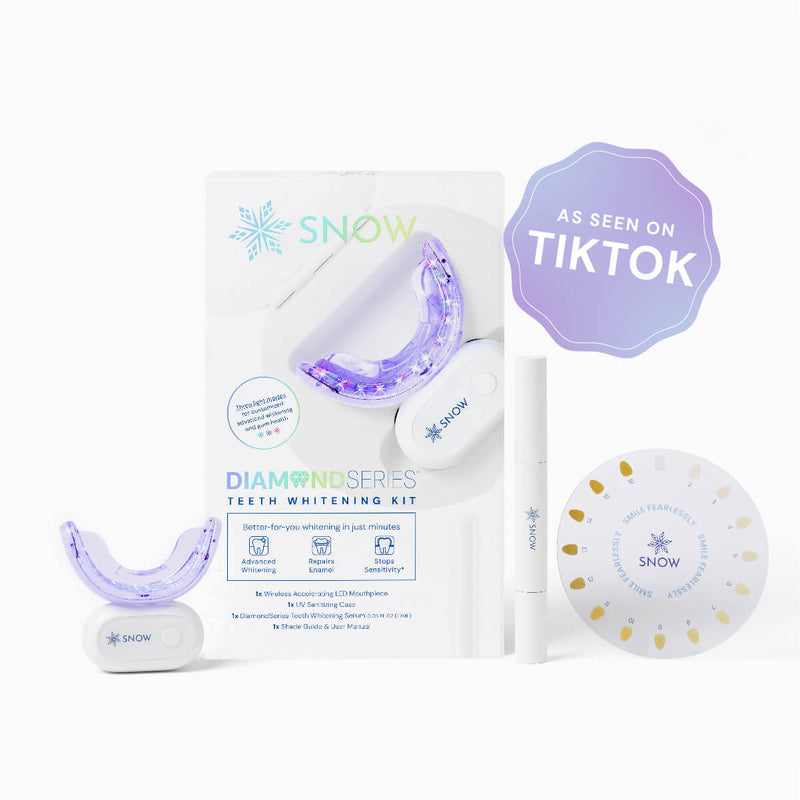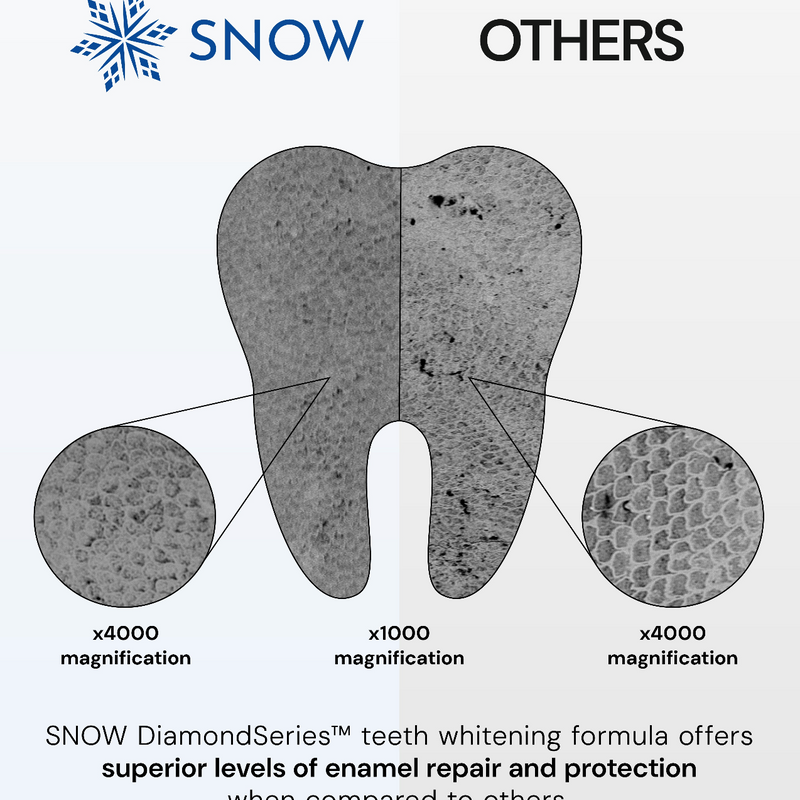Can your teeth become white again by brushing alone? The short answer is no; regular brushing, while essential for dental health, isn't enough to reverse discoloration and achieve a whiter smile.
However, if you've noticed your teeth getting yellow despite brushing, don't fret! This comprehensive guide will explore the realities of tooth color, the true impact of brushing, and more effective whitening alternatives.
From professional treatments to at-home solutions like SNOW's innovative products, we'll delve into safe, effective ways to brighten your smile.
Get ready to embark on a journey toward that dazzling smile you've always desired!
What this article covers:- The Science of Smile: What Determines the Color of Your Teeth?
- The Brushing Conundrum: Is It the Road to Whiter Teeth?
- Amplifying Your Efforts: At-Home Whitening Solutions
- Realistic Expectations: The Journey to a Whiter Smile
- Optimizing Your Routine for a Brighter Smile
- The Holistic Approach: Maintaining Your Whiter Teeth
The Science of Smile: What Determines the Color of Your Teeth?
Understanding tooth color requires a quick lesson in dental anatomy. Our teeth aren't just white or yellow; they have a natural hue that can range from light grey to a more creamy color. This natural coloration is influenced by several factors:
- Genetics: Just as we inherit our eye and hair color, we also inherit our tooth color. This genetic roulette determines the thickness and smoothness of the enamel, which influences the reflection of light and, consequently, the color.
- Age: Over time, the outer enamel layer gets thinner with brushing and more transparent, allowing the yellow color of dentin — the tooth's core material — to show.
- Enamel Quality: Thinner enamel allows more of the dentin's color to show through. Factors like a high-fever at a young age, trauma, or use of tetracycline antibiotics during childhood can affect enamel quality and color.

Table: Factors Affecting Tooth Color
|
Cause |
Substances/Conditions |
Effect On Teeth |
|
Food and Drink |
Coffee, tea, red wine |
Stains on enamel |
|
Tobacco Use |
Tar and nicotine |
Yellow/brown stains |
|
Medications |
Certain antibiotics and antipsychotics |
Darkening of tooth color |
The Brushing Conundrum: Is It the Road to Whiter Teeth?
Brushing plays a crucial role in maintaining dental health by removing food particles and minimizing plaque — a sticky, colorless film of bacteria that forms on your teeth. However, when it comes to whitening, the story is a bit different.
Regular toothbrushes handle surface stains, but they don't change the intrinsic color of your teeth. For that, you need the best teeth whitening toothbrush and a whitening agent.
Whitening toothpastes can be somewhat effective for surface stains, as they contain mild abrasives and chemicals to polish the teeth and bind to stains.
However, they're not always effective against deeper, set-in discoloration. And if you're wondering, can an electric toothbrush whiten teeth better?, the answer is that while they might be more efficient at removing surface stains, they too can't alter the intrinsic color.

Table: Brushing vs. Intrinsic Discoloration
|
Method |
Effectiveness |
Limitations |
|
Regular Brushing |
Removes surface debris and stains |
Doesn't alter intrinsic tooth color |
|
Whitening Toothpastes |
Targets surface stains |
Limited effect on deep discoloration |
Amplifying Your Efforts: At-Home Whitening Solutions
While regular brushing is a key part of oral hygiene, for those pearly whites, you'll need to step up your game. That's where SNOW comes in. Our cutting-edge at-home teeth whitening kits are designed to tackle those stubborn stains that regular brushing can't.
Our system uses a unique formula in conjunction with LED technology to provide professional-quality results from the comfort of your home. And the best part? Our products are formulated to be safe for sensitive teeth, ensuring a comfortable whitening experience.
Table: SNOW At-Home Whitening
|
Feature |
Description |
|
Advanced Formula |
Designed to remove deep stains |
|
LED Technology |
Accelerates the whitening process |
|
Safe for Sensitive Teeth |
Gentle and effective formula |
Realistic Expectations: The Journey to a Whiter Smile
Teeth whitening isn't an overnight process. It's important to have realistic expectations and be patient. The duration it takes to see results can vary based on the extent of tooth discoloration and the type of whitening system used.
With SNOW, most users see results within three weeks, with some noticing a difference much sooner. Remember, consistency is key, so make sure to follow the recommended usage instructions for the best outcome.
Table: Whitening Expectations With SNOW
|
Extent Of Discoloration |
Expected Duration |
|
Mild |
As soon as three days |
|
Moderate |
One to three weeks |
|
Severe |
Three weeks or more |
Optimizing Your Routine for a Brighter Smile
Getting the most out of your whitening experience means optimizing your routine. Here are some quick tips:
Brush And Floss Regularly
Good oral hygiene is the foundation of any whitening regimen. It helps remove food particles that could interfere with the whitening agent. And if you've ever wondered about brown spit when brushing teeth or yellow spit after brushing teeth, it's often a sign of accumulated plaque or food particles, emphasizing the importance of regular dental hygiene.
Follow Product Instructions
Each SNOW kit comes with detailed instructions. For best results, follow them to the letter.
Avoid Stain-Causing Foods And Beverages
Certain foods and drinks are notorious for staining teeth. Try to avoid them, or brush immediately after consuming.
Regular Touch-Ups
After achieving your desired shade, regular touch-ups will help maintain your bright smile.
The Holistic Approach: Maintaining Your Whiter Teeth
A bright smile is a journey, not a destination. Maintaining that radiant glow requires a holistic approach:
Balanced Diet
A diet rich in fruits, vegetables, and adequate calcium promotes oral health and naturally scrubs your teeth.
Lifestyle Adjustments
Quitting smoking and limiting food that stains your teeth will have a significant impact on keeping your teeth whiter.

Conclusion
In essence, while regular brushing is fundamental for dental health, achieving a truly radiant smile often requires an extra step. Can your teeth become white again by brushing alone? The answer leans towards the negative, especially for deep-set stains.
However, with advanced teeth whitening solutions like those offered by SNOW, a gorgeous smile is not just a dream, but a convenient, affordable reality.
Embrace the journey to a brighter, confident smile with SNOW — where innovation meets convenience, and where your smile's brilliance is our success story.
If you found this article helpful, check out some of these related posts:
- Do You Brush Your Teeth Before Whitening Gel
- How Long Does It Take for Yellow Teeth to Turn White with Toothpaste
- Does Brushing Your Teeth More Often Make Them Whiter
- What Is the White Stringy Stuff in My Mouth After I Brush My Teeth
- How to Whiten Teeth Instantly
- Can Yellow Teeth Become White?
- Can I Whiten My Teeth Twice a Day?
- Best Time to Whiten Teeth
- How Long Does It Take to Whiten Teeth?
- How Long Do Zingers Last After Teeth Whitening?
- How Long Does It Take to Whiten Teeth with Strips?
- How Long to Whiten Teeth with Trays
- How to Treat Burned Gums From Teeth Whitening
- How Long Will My Gums Stay White After Teeth Whitening?
- White Spots on Teeth Near Gums
























